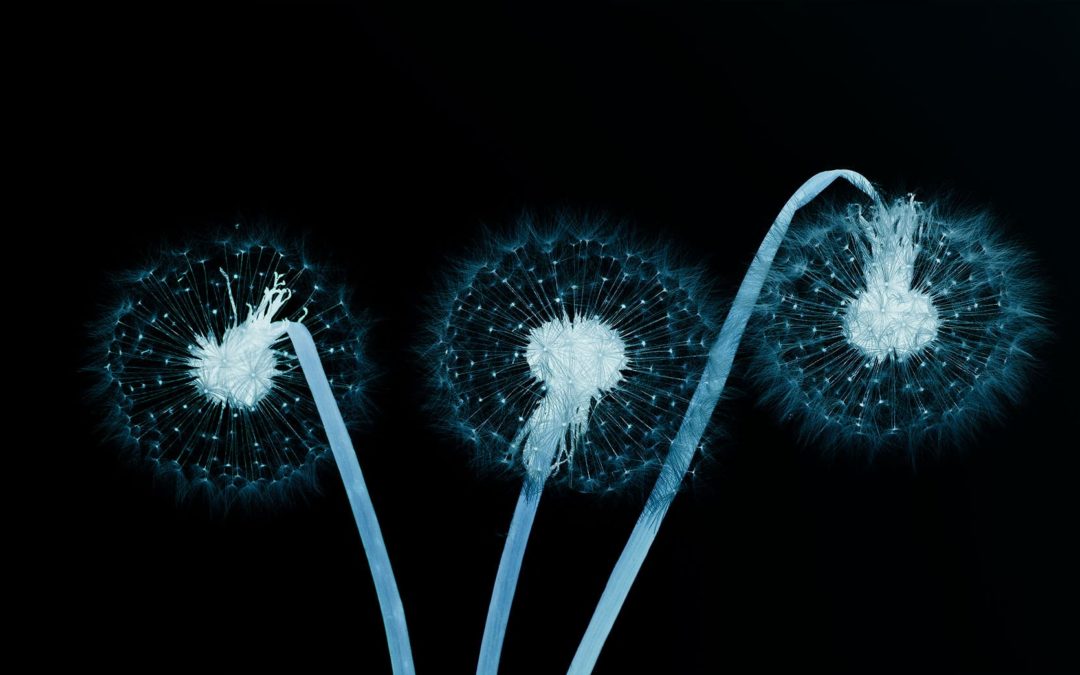La leggenda del soffione
“Tarassacus” from Xray flowers series ©LuzzitelliDanieli
Si narra che Teseo mangiò per 30 giorni di fila solo denti di leone allo scopo da diventare abbastanza forte da affrontare e sconfiggere il Minotauro.
In passato, applicando la cosiddetta ‘teoria delle Segnature’, si riteneva che il soffione avesse il potere di curare l’itterizia. Secondo questa teoria, ogni pianta o frutto rispecchia nella forma o nel colore quella parte o quell’ organo del corpo umano che è destinata a curare.
Quindi, i fiori gialli del tarassaco, per segnatura del colore, erano idonei a curare l’ittero e i disturbi del fegato. Oggi sappiamo che effettivamente il tarassaco è utile nella cura del fegato, anche se il motivo non risiede nel colore dei fiori.
Il soffione è legato all’idea del distacco e del viaggio. I semi di questo fiore sembrano rappresentare perfettamente le fasi del ciclo della vita che ognuno di noi è destinato a compiere.
Inizialmente i semi sono legati al pappo, la loro appendice soffice, e sembra non vogliano staccarsene. Poi pian piano si lasciano trasportare dal vento, dapprima timorosi, man mano sempre più impavidi, pronti a intraprendere un nuovo viaggio, a sperimentare nuove avventure.
Superata la paura iniziale, si lasciano andare al flusso della vita, curiosi di nuove scoperte, pronti a generare nuova vita.
Il loro percorso rappresenta una metafora perfetta della vita di ognuno di noi: per poter fiorire, ciascuno deve staccarsi dalla propria origine, affrontando il proprio viaggio senza paura, pronto a lottare contro le intemperie e a cogliere ogni opportunità.
Un altro significato del soffione è rappresentato dall’infanzia e dall’innocenza.
Sono soprattutto i bambini, infatti, a soffiare su questo fiore disperdendone i semi. In questo caso, il simbolismo non ha un significato negativo, ad indicare qualcosa che si è perduto per sempre, ma piuttosto una connotazione positiva legata al ricordo di un bel passato e quindi , alla speranza di un futuro altrettanto roseo.
It is said that Theseus ate only dandelions for 30 days in a row in order to become strong enough to face and defeat the Minotaur.
In the past, applying the so-called ‘Signature theory’, it was believed that the shower head had the power to cure jaundice. According to this theory, each plant or fruit reflects in shape or color that part or organ of the human body that it is intended to cure.
Therefore, the yellow flowers of the dandelion, by color signature, were suitable for treating jaundice and liver disorders. Today we know that dandelion is actually useful in liver care, even if the reason is not in the color of the flowers.
The shower head is linked to the idea of detachment and travel. The seeds of this flower seem to perfectly represent the phases of the life cycle that each of us is destined to complete.
Initially the seeds are tied to the pappus, their soft appendix, and it seems they don’t want to detach from it. Then slowly they let themselves be carried away by the wind, at first fearful, gradually more and more fearless, ready to embark on a new journey, to experience new adventures.
Having overcome the initial fear, they let themselves go to the flow of life, curious for new discoveries, ready to generate new life.
Their path represents a perfect metaphor for the life of each of us: in order to flourish, everyone must detach from their origin, facing their own journey without fear, ready to fight against the elements and to seize every opportunity.
Another meaning of the shower head is represented by childhood and innocence.
In fact, it is above all children who blow on this flower, dispersing its seeds. In this case, the symbolism does not have a negative meaning, to indicate something that has been lost forever, but rather a positive connotation linked to the memory of a beautiful past and therefore, to the hope of an equally rosy future.

